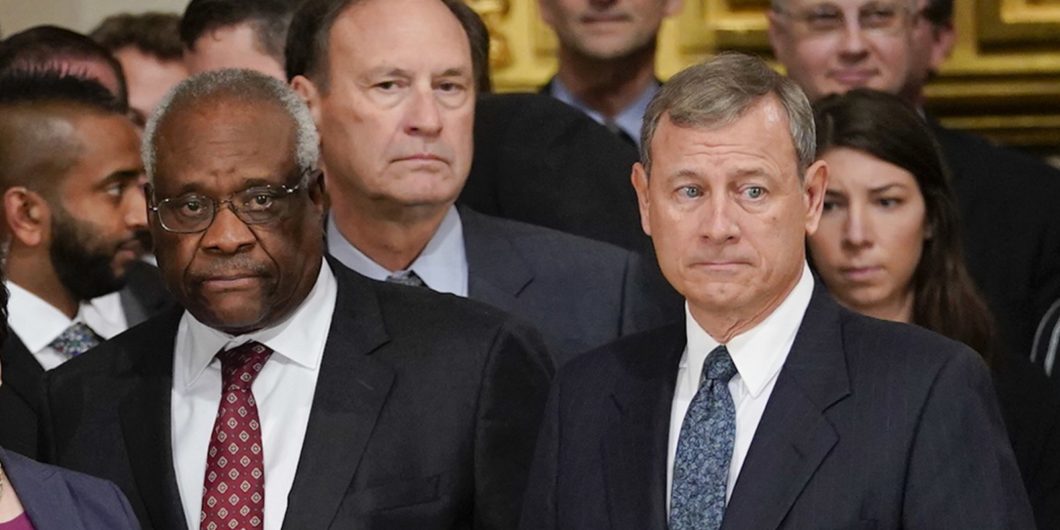We need not pretend that constitutional and legal philosophies do not map consistently onto substantive political outcomes.
Roberts and Thomas Battle Over Burke
The most important question for the Supreme Court today is the relation of stare decisis to original meaning. Five justices on the Court today adhere, at least most of the time, to some form of originalism when there is no precedent that gets in the way of vindicating the actual Constitution. But, unfortunately, nonoriginalist precedents abound, because both the New Deal Court and the Warren Court had a majority of justices who believed in updating the Constitution to capture progressive principles. In two important cases decided this past Monday, June Medical Services v. Russo and Seila Law v. Consumer Financial Protection Bureau, stare decisis was front and center, as was the great conservative champion of adherence to the examples of the past, Edmund Burke.
In Seila, Chief Justice John Roberts, as I had predicted at this site, held that insulating the Director of the CFPB from presidential removal was unconstitutional because it violated the separation of powers. The reason is that “The President’s executive power generally includes the power to supervise—and, if necessary, remove—those who exercise the President’s authority on his behalf.”
The problem of stare decisis in this case is that the Court has upheld restraints on the president’s removal authority, most notably in Humphrey’s Executor v. United States, in which the Court held that independent multimember commissions whose members are appointed from both parties cannot be dismissed at will by the President. Roberts simply limits such cases to their results, not their reasoning. And the CFPB is factually different from most independent agencies in two ways: It has a single director rather than a board of politically balanced commissioners, and it has an independent funding source, enjoying access to a percentage of the revenues of the Federal Reserve, another independent agency.
Thus, Roberts is free under his view of stare decisis to strike down the CFPB’s removal provision because it conflicts with the Constitution’s requirement of a unitary executive in which the president has complete supervisory power. The factual situations of previous cases are protected by stare decisis, but their rationales fall if they conflict with original meaning. One way of encapsulating Roberts’ view is that stare decisis only incorporates results, not the reasoning necessary to arrive at those results.
Justice Clarence Thomas, in concurrence, would clearly have gone further. He would have made clear that Humphrey’s Executor was no longer good law even for independent commissions. That stance is consistent with his view that precedents should be overruled if they are demonstrably erroneous.
In June Medical v. Russo, stare decisis was also at issue and the Chief Justice’s vote was also controlling in a 5-4 decision, although in this case, he wrote not for a majority but only for himself. June Medical concerned the constitutionality of a Louisiana requirement that abortion providers also have admitting privileges at hospitals not less than 30 miles away from the abortion providers’ facility. In Whole Woman’s Health v. Hellerstedt (2016), the Court, also in a 5-4 decision, had invalidated a similar provision in Texas. Both cases turn on Planned Parenthood v. Casey’s framework for deciding abortions cases. Casey‘s doctrine precludes laws that “have the effect of presenting a substantial obstacle to women seeking an abortion.”
The salient difference between the unwritten traditions Burke extolled and constitutional law is that the Constitution is a written document against which subsequent interpretations must be measured.
Roberts had dissented in Whole Woman’s Health and would have upheld the admitting privileges requirement there, but here he struck the requirement down on stare decisis grounds. And he did so because he believed that the cases presented the same factual circumstances, although he disagreed with the rationale of Whole Woman’s Health. In that case, Roberts argued, the majority had wrongly balanced the benefits of the regulation against the burden on the abortion right. Roberts stated that this was the wrong test, because Casey did not require such balancing. Only a substantial burden on the woman’s right to abortion would serve to invalidate the law without regard to the strength of the state’s rationale for its restriction.
Thus, in June Medical, Roberts voted to invalidate an abortion restriction on the basis of a decision from which he himself dissented and which he recognizes was based on erroneous reasoning. His vote wholly depends on a claim of stare decisis dictated by the factual similarity of the two cases. This reasoning parallels his refusal to cast doubt on the constitutionality of the many multimember commissions, like the Securities and Exchange Commission, that dot our nation’s capital, because they are more similar factually to the commission at issue in Humphrey’s Executor.
This position again contrasts with Justice Thomas’ position, which would overrule a decision if it were demonstrably erroneous, as Roberts believes Whole Woman’s Health was. (In June Medical, Thomas would have overruled Roe itself, but Roberts and other conservative justices did not consider that question, because Louisiana did not ask for Roe to be reconsidered.)
While I do not fully agree with Justice Thomas that any demonstrably erroneous precedent should be overturned, I find Roberts’ greater reluctance to overturn precedents on the basis of their factual similarity untenable. The judiciary is an institution that makes decisions based on reasons. Why should it continue to follow those decisions simply because the facts are similar if its reasons for a previous decision are shown to be wrong?
Roberts relied on the sonorous prose of conservatism’s greatest philosopher—Edmund Burke—to justify his position in June Medical: “This principle [of stare decisis] is grounded in a basic humility that recognizes today’s legal issues are often not so different from the questions of yesterday and that we are not the first ones to try to answer them. Because the ‘private stock of reason . . . in each man is small . . . individuals would do better to avail themselves of the general bank and capital of nations and of ages.'”
It is far from clear, however, that Burke would tell us to stick with the facts but discard the rationales of prior legal decisions. Indeed, the quote from Burke here notably focused on reason. Humility would suggest not discarding considered reasons as well as facts. But the salient difference between the unwritten traditions Burke extolled and constitutional law is that the Constitution is a written, carefully deliberated document against which all subsequent interpretations must be continually measured.
Moreover, Burke elsewhere uses age as an indication of truth. And the rationale of Humphrey’s Executor, a case decided eighty-five years ago and cited favorably by the Court many times, has been part of the law much longer than the facts of Whole Woman’s Health, a case decided four years ago. As Thomas noted in his dissent, “no one can seriously claim” that Whole Woman’s Health is “part of the ‘inheritance from our forefathers’” that Burke so valued.
To be sure, there may be other reasons not to discard precedents, like reliance that individuals may have placed in them and the chaos that overruling may cause. I do not believe either rationales are strong arguments for following the precedent in either case here. No one argues, for instance, that a Louisiana abortion provider built a practice in reliance on Whole Woman’s Health.
It is true that the media would have highlighted and criticized the reversal in June Medical because the question of abortion so divides our nation. In contrast, no one outside the beltway and the legal academy cares much about the removal process for executive agency heads. But stare decisis must above all reflect the rule of law, not considerations of how the decision will play on the nightly news.



